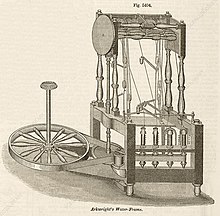Spinning frame

The spinning frame is an Industrial Revolution invention for spinning thread or yarn from fibres such as wool or cotton in a mechanized way. It was developed in 18th-century Britain by Richard Arkwright and John Kay.
Historical context
In 1760 England, yarn production from wool, flax and cotton was still a
Development
Richard Arkwright employed John Kay to produce a new spinning machine that Kay had worked on with (or possibly stolen from) another inventor named Thomas Highs.[2] With the help of other local craftsmen, including Peter Atherton, the team developed the spinning frame, which produced a stronger thread than the spinning jenny invented by James Hargreaves.[3] The frame utilised the draw rollers invented by Lewis Paul to stretch, or attenuate, the yarn.
The roller spinning process starts with a thick 'string' of loose fibres called a roving, which is passed between three pairs of rollers, each pair rotating slightly faster than the previous one. In this way it is reduced in thickness and increased in length before a strengthening twist is added by a bobbin-and-flyer mechanism. The spacing of the rollers has to be slightly greater than the fiber length to prevent breakage. The nip of the roller pairs prevents the twist from backing up to the roving.[4]
Too large to be operated by hand, the spinning frame needed a new source of power. Arkwright experimented with horses, but decided to employ the power of the water wheel, which gave the invention the name 'water frame'.
For some time, the stronger yarn produced by the spinning frame was used in looms for the lengthwise
In France,
In the British Isles, James Kay was initially credited with the invention of this device. On 2 December 1826 shortly after Kay's patent was awarded, Philippe Henri de Girard wrote to the Editor of
A few months ago, a gentleman of the name of Kay, excited a strong sensation in the trade, by announcing a new method of spinning flax, by which much finer and better yarn was produced, than by any other process previously adopted. He announced this invention not only as new, but as his own; the results of his experiments were published in many provincial and London papers; and he granted to several flax-spinners, the right of using his invention, for which he obtained a patent. The public will now hear, perhaps with some astonishment, that all this noise was made for a discovery long since published on the continent, and even patented in England twelve years ago. This new process of spinning, announced by Mr. Kay, is the same which I invented fourteen years since, and which is established, with great success, in France, Saxony, and Germany. A patent was taken out in England, in the month of May, 1815, by my partners in Paris, Messers. Cachard and Lanthois, in the name of Mr. Horace Hall.
Kay's patent was invalidated, in 1839, on the grounds it was too similar to Horace Hall's; A decision upheld on appeal, in 1841.[6]
Notes
- ^ Hammond & Hammond 1919, p. 50.
- ^ "Thomas Highs and his spinning machines". Cotton Times. 2006-10-10. Archived from the original on 2008-05-14.
- ^ Aikin, John; Enfield, William (1799). General Biography. Vol. 1. London: G.G. and J. Robinson. pp. 391–2.
- ISBN 0415147921.
- ^ Hammond & Hammond 1919, p. 51.
- ISBN 979-8651909896.
Bibliography
- Hammond, J. L.; Hammond, Barbara (1919). The Skilled Labourer 1760–1832 (PDF). London: Longmans, Green and Co.
External links
- Essay on Arkwright, showing his links with Kay and Highs.


